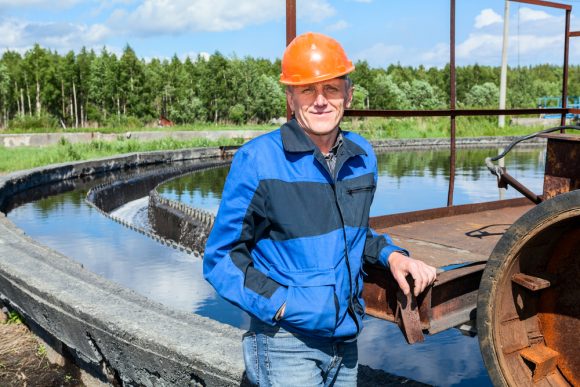Experience the world’s most efficient wastewater remediation products, for operational stability of municipal wastewater treatment plants.
Bio Energizer® reduces grease & odor in wastewater sludge
Using Micro Carbon Technology® (MCT), Bio Energizer® is a scientific formulation of organic acids, buffers, natural biological systems, nutrients and energy systems that balance the natural microbial ecosystem to increase bio-oxidation capacity. Bio Energizer® increases the bio-oxidation of wastewater and efficiently reduces sludge and odor levels in wastewater treatment plants, lagoons, and ponds, and reduces grease problems in sewer lines and lift stations.
Bio Energizer® is the most cost-effective sludge removal tool:
- Less than 1/10th the cost of sludge handling / mechanical dredging
- Less than 1/100th the cost of building a new treatment facility
Benefits of Use:
- stimulates existing microbiology
- reduces noxious odors
- digests fats and greases
- drying beds dry faster
- reduces sludge buildup
- increases dissolved oxygen levels
- improves flocculation and settleability
- an economical alternative to mechanical sludge removal, eliminating handling costs and out-of-service time
Bio Genesis® reduces filamentous bacteria, solving issues with settling and turbidity
Bio Genesis® with MCT is a formulation of nutrients, organic acids, natural biological stimulants, and energy systems that balance the natural microbial ecosystem to increase bio-oxidation capacity in activated sludge systems. Bio Genesis® reduces operating costs by lowering BOD/COD and improving settleability while controlling filamentous bacteria and reducing FOG. Bio Genesis® stimulates the activity of beneficial bacteria in activated sludge systems, improving overall operational stability. This reduces the BOD/COD and stabilizes the oxygen ratio in wastewater. Bio Genesis® complexes with ions in the water to increase the availability of key nutrients that were previously blocked.
- Improves flocculation and settleability
- Improves SVI
- Increases dissolved oxygen levels
- Decreases mechanical aeration and energy costs
- Reduces noxious odors
- Reduces coagulant and flocculant chemical use and costs
- Minimizes upsets
- Reduces chlorine disinfection demands
- Reduces filamentous bulking, foaming, and scum
- Reduces wasting, sludge volume, and out-of-service time
- Improves effluent water quality
Micatrol® detoxifies chemicals
Micatrol® is a probiotic formulation of complexing agents, organic acids, buffers, nutrients, and energy systems that enhances biological degradation. Micatrol® catalyzes the breakdown of chemical and petroleum compounds and promotes microbial digestion causing biodegradation into harmless byproducts of carbon dioxide, water, and humus. It is effective in detoxifying chemicals. Micatrol® is complexed with MCT to ensure better deliverability of nutrients to plants and microorganisms.
Benefits of use:
- buffers microbes from chemical toxicity
- breaks down chemical or petroleum contamination in sludge, digesters, and lagoons.
- complexes heavy metals and salts, reducing toxicity
Our products are used in
- lagoons and ponds
- activated sludge plants (oxidation ditch, SBR, membrane)
- digesters (aerobic and anaerobic)
- solids holding tanks
For more information on these and other Probiotic Solutions® products, visit https://probiotic.com/shop.
Micro Carbon Technology®
Using Micro Carbon Technology® (MCT) as a base, we have developed many highly efficient products for maximum microbial stimulation in wastewater to reduce sludge, cut down on odor, lower BOD/COD levels, improve nitrogen removal, and lower operating costs. Wastewater, in its untreated form, usually does not meet all of the conditions for optimal microbial activity that leads to the breakdown of waste solids. When microbial activity is not optimized, sludge accumulates, odor gets out of control, and COD/BOD/FOG levels fall out of compliance with government regulations.
Key benefits of MCT include:
- non-selective: works with both positive and negative elemental ions
- versatile delivery: hand application, spray, or single-pumping system
- low energy: requires less effort from the microorganisms to uptake nutrients, lowering BOD
Related Posts

Caffeine in Our Water Supply: Do Our Habits Pollute the Environment?
Caffeine is excreted by the body and flushed into our wastewater. Wastewater, in turn, is treated and recycled back into the environment, or––in some cases––directly back into drinking water.

Strengthening the Biostimulant Movement with HPTA
By Lyndon SmithPresident and CEO,Bio Huma Netics, Inc. We attended the Humic Products Trade Association (HPTA) annual meeting this past month in Park City, Utah. It’s always a pleasure to get together with industry peers and talk about issues pertaining to HPTA as well as discussing the latest and the greatest research and product developments...

BHN’s Lyndon Smith to Speak at New AG International Africa Conference
Bio Huma Netics, Inc., President and CEO Lyndon Smith has been selected to speak at the New AG International—Africa Conference, to be held April 6–8 in Marrakesh, Morocco. The full conference title is “A 360-Vision of Specialty Fertilizer, Precision Ag, Irrigation, and Biostimulant Developments in Africa.” Mr. Smith’s presentation, titled “The biostimulant effect of humic...


